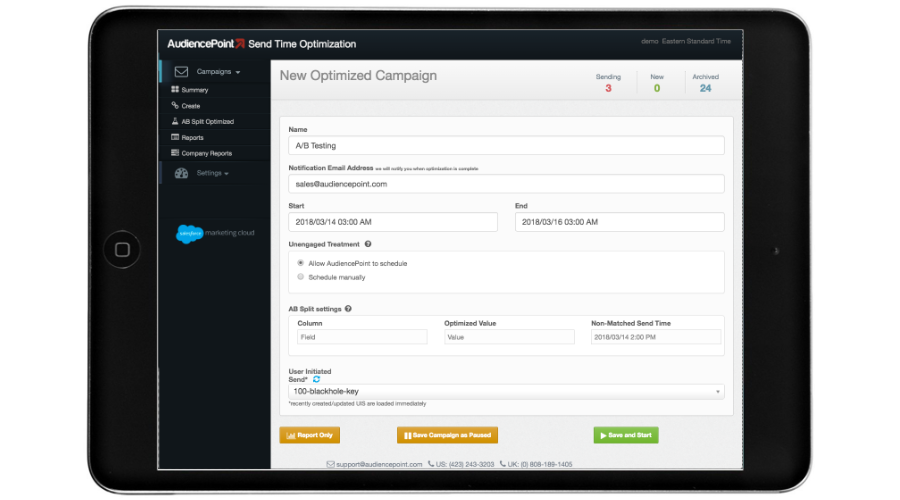AudiencePoint is thrilled to announce our new integration with Klaviyo! AudiencePoint is looking for partners to pilot our...
Granted, the title has a touch of hyperbole, but big changes in our industry are on the way. Most notably, Apple recently announced they will be pre-caching tracking pixels from marketing emails when their new operating system is released this fall. This means the underlying tech for tracking who opens marketing emails will become obsolete. The news has caused quite a stir in our industry, as marketers and technology providers rely heavily on open tracking to power everything from automation to analytics. From an impact standpoint, there are approximately 113 million iPhone users. Assuming all those users rely on the Apple email client on their iPhones, the lack of reliability of those open signals will create serious challenges for marketers moving forward.
So what should Marketers do to overcome the Apple open tracking challenge?
- Dig deeper in the data you do have.
As marketers in the new normal, we will have to push for more insight from every signal we get. What does a click tell us beyond knowing it happened? Constraints can become opportunities to distinguish ourselves, but it will take work to get there. - Consider qualitative signals
Has our reliance on data suppressed other – and perhaps more meaningful – channels for feedback? Probably. Almost definitely. New normal marketers will need to build new feedback loops for subscribers to give us direct, raw, emotional, sometimes irrational musings on how we’re doing. And we will grow as a result. - Find new sources of data about your subscribers
Second-party data (aggregated first-party data) is a powerful concept that marries several important individual concepts – privacy, big data, AI, and data integrity – into a modern solution for marketers. Second-party data offers a holistic, global view of subscribers, and paints a picture of an individual’s engagement patterns across many senders, simultaneously.
The AudiencePoint perspective enables marketers to be less reliant on their own (now significantly limited) data, and make sending and segmentation decisions based on how their subscribers behave with many brands and campaigns – a much more accurate lens.
How does second-party data work?
Like in a jigsaw puzzle, a single piece doesn’t show you very much, but collectively, a clear picture emerges. Data is similar. One data point, or a metric, or even a brand’s full analytics only gives us a singular view of a subscriber. On the other hand, when subscriber signals are aggregated across many brands, products, and content, a much clearer view of that same subscriber emerges. We can see patterns of behavior we were blind to with a single, limited vantage point.
Why AudiencePoint Data?
We’ve been in the game a long time. Reliable, large datasets take time to build, validate, and extract proven insights. We’ve been accumulating engagement activity for over 6 years and have one of, if not the largest, privacy-compliant data sets on the planet. And in a time where our visibility into email campaigns is about to take a huge step back due to Apple open tracking, it’s more important than ever to have reliable benchmarks and metrics to inform decisions.
Relevance of Historic Data Pool.
We have analyzed billions of unique email addresses across more than 160 enterprise clients. 500 million of those have enough data which we can curate. Our view into historial open and engagement patterns will be a valuable lens for brands with limited analytics in the future.
Our data pool contains:
Over 12 billion Open events
Over 2.1 billion Click events
Over 12.1 billion Send events
Over 9 million unsubscribe records (FOR 2021 ALONE)
Over 26 million Bounce records (FOR 2021 ALONE)
Interactions across industries of 500 million users
We use historical data and the correlation + interaction of different engagement events, then cross-reference with our algorithm to determine the best time to send, the frequency of optimal sends for each customer, what industries with whom they are most engaged, and how active (and valuable) they are for our customers. Additionally, as one investor told me, this historic data pool takes more relevance now. In his words:
“Some data is better than no data, and you have a lot of data!
The Importance of Aggregated Second-Party data
The fact that we “pool” data directly from over 160 Enterprise brands allows our clients to securely leverage information from multiple sources, without breaching important privacy laws, like SDPR or CCPA. Most other analytics solutions rely exclusively on first-party data. It naturally follows that reduced visibility down that single data stream will negatively affect quality. The bottom line? Any solution in the stack that relies on first-party data to predict behavior will be less reliable in the new normal. Our approach allows customers to securely leverage insights beyond the scope of their own program and is far less likely to be skewed by the behavior of any single brand or technology. Even if those brands are large providers like Apple.
Marketers need deeper, more relevant metrics
Due to the aggregation of our data from multiple sources, not only can we determine how generally active a customer is, but specifically across specific industries and competitors. Correctly targeting each customer segment becomes significantly more important as opens become less reliable. Knowing who to send and who NOT to send is of keen importance. The only way that can be accurately understood is by programmatically validating engagement patterns across a wide variety of sources. We have the best source of aggregated data in the industry.
At AudiencePoint, we believe marketing can embrace privacy and transparency simultaneously. Brands can all maintain their distinct brand promises and help others do the same. Marketing is not a zero-sum game and we’re embracing this ethos with the products we’re building.
What’s Next?
In the future, we will expand our dataset to include user agent (what software the end-user uses) and device type (desktop, mobile, etc) to help us Identify false/pre-cached opens coming from Apple, and to give customers insights into what devices their recipients are using to open their email and when. Do they exclusively use Gmail? Do they use one email client on mobile and another on desktop? These insights will help combat the analytics gap created from unreliable open tracking.
Don’t let the Apple open tracking news scare you. We’re here to help.





